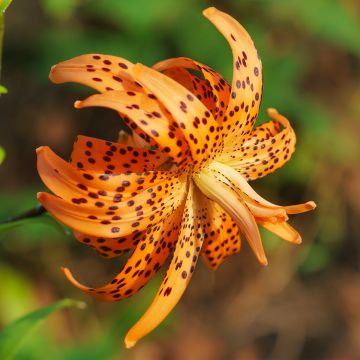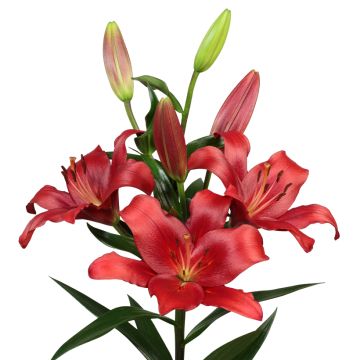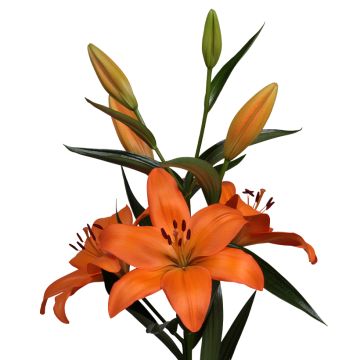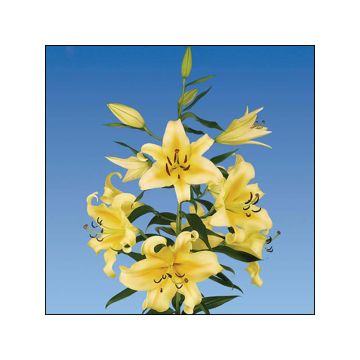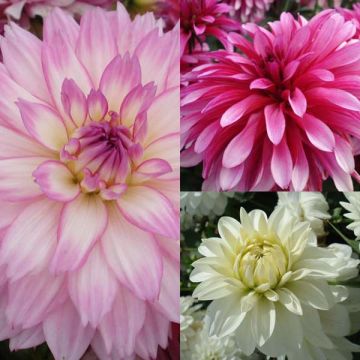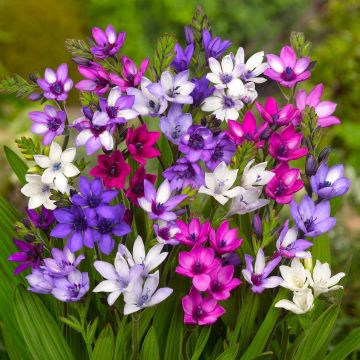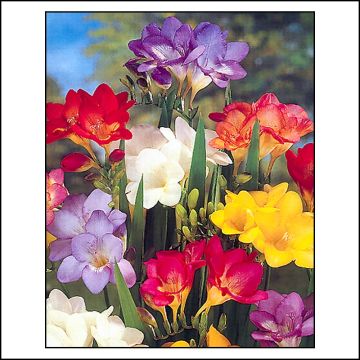Shipping country and language
Your country of residence may be:
Your country of residence is:
For a better user experience on our website, you can select:
Your shipping country:
-
Andorra
-
Austria
-
Belgium
-
Bulgaria
-
Canada
-
Chile
-
Croatia
-
Cyprus
-
Czechia
-
Denmark
-
Estonia
-
Finland
-
France
-
Germany
-
Greece
-
Hungary
-
Iceland
-
Ireland
-
Italy
-
Latvia
-
Lithuania
-
Luxembourg
-
Malta
-
Monaco
-
Netherlands
-
Poland
-
Portugal
-
Romania
-
Slovakia
-
Slovenia
-
Spain
-
Sweden
-
Switzerland
-
United Kingdom
We only deliver seed and bulb products to your country. If you add other products to your basket, they cannot be shipped.
Language:
-
French
-
German
-
Spanish
-
English
-
Italian
My Account
Hello
My wish lists
Log in / Register
Existing customer?
New customer?
Create an account to track your orders, access our customer service and, if you wish, make the most of our upcoming offers.


Lilium x asiatica Forever Susan - Asiatic Lily
Lilium x asiatica Forever Susan - Asiatic Lily
Lilium x asiatica Forever Susan
Asiatic Lily
Order in the next for dispatch today!
Dispatch by letter from €3.90.
Delivery charge from €5.90 Oversize package delivery charge from €6.90.
More information
This item is not available in your country.
Schedule delivery date,
and select date in basket
This plant carries a 6 months recovery warranty
More information
We guarantee the quality of our plants for a full growing cycle, and will replace at our expense any plant that fails to recover under normal climatic and planting conditions.
From €5.90 for pickup delivery and €6.90 for home delivery
Express home delivery from €8.90.
Does this plant fit my garden?
Set up your Plantfit profile →
Description
The Asian lily 'Forever Susan' is a variety that offers remarkably colourful flowers that have a great impact in the garden and in bouquets. It is a rather early, sturdy and very floriferous cultivar. Easy to grow in any well-drained garden soil, this quite fantastic plant is within reach of novice gardeners. Once well established, it faithfully blooms every year and multiplies spontaneously. Also create a superb bouquet by combining it with small white flowers.
The genus Lilium belongs to the Liliaceae family, its representatives are bulbous plants whose vegetation is deciduous in winter. Their bulb rests underground during winter. Asian hybrids are floriferous and robust lilies, without fragrance, offering a wide range of bright colours. These plants flower early in the season, are very hardy, and their cultivation poses no particular difficulty.
The Lilium 'Forever Susan' is a Dutch horticultural selection from Lily Company B.V. dating back to 2010. Its vegetation starts around April, to produce a leafy stem. It will reach 90 cm to 1.10 m in height when flowering, depending on the bulb size and growing conditions. The plant will spread indefinitely over time, with bulbs producing bulblets through vegetative propagation. Flowering occurs from mid-June to mid-July, depending on the climate. Towards the top of the leafy stems, several upright flowers measuring up to 12 cm in diameter form on a mature plant. Inside the petals, there is a beautiful deep orange-red violet, enhanced by a large flame-shaped spot in shades of dark red-violet and dark brown. The throat displays a bright orange-red, with a honey-green groove. Externally, the petal edges show a gradient from brown-orange to orange-red, with a slight light green reflection at the base and along the central vein. The inside of the petals is orange-red, with brown-orange nuances above and around the central vein. Some brown-violet spots dot the petals, which are without papillae and smooth, slightly curved. The pollen is a bright orange-brown. The leaves are a fresh green, measuring about 10.5 cm long by 1.1 cm wide. The green stem supports up to five flowers.
A bulbous plant requiring light and fertile soil, this 'Forever Susan' lily will thrive year after year in any well-balanced and well-loosened soil. It brings an exotic and bold touch to the garden with its flamboyant tones. Plant it in groups in a sunny flower bed or border, it can become the centerpiece of a plant scene. To enhance its remarkable colours, it can be paired with Echinacea purpurea 'Magnus' with fuchsia pink flowers, 'Crimson Pirate' daylily with bright red petals, and 'Midnight Blue' Agapanthus producing intense blue umbels. Together, these plants create an exotic tableau, without requiring complex growing conditions. This medium-sized lily is naturally sensational in bouquets.
Report an error about the product description
Lilium x asiatica Forever Susan - Asiatic Lily in pictures
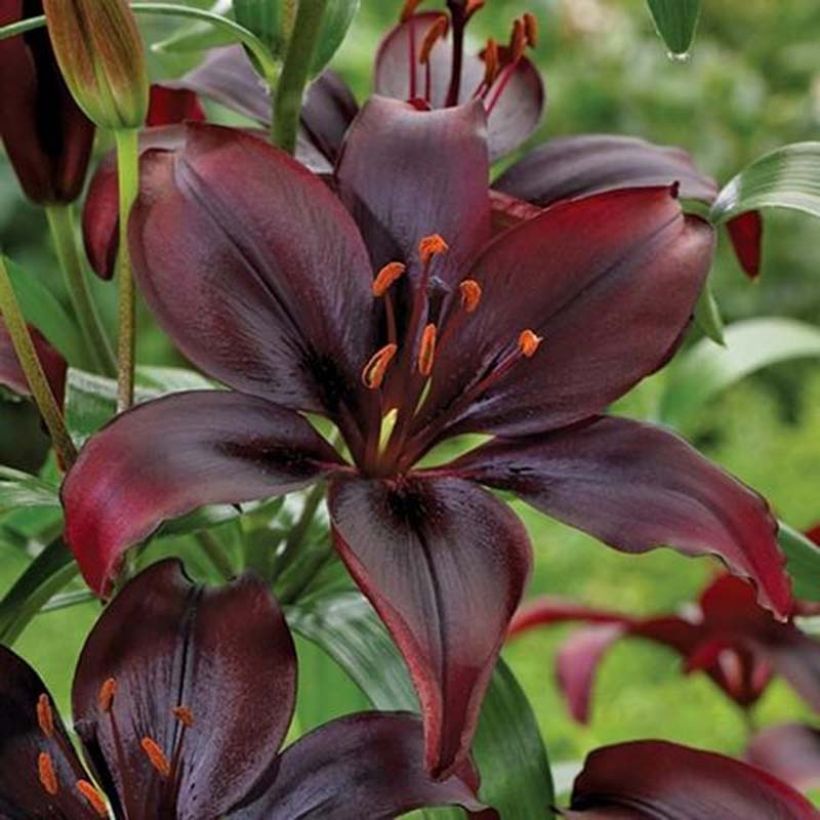

Plant habit
Flowering
Foliage
Botanical data
Lilium
x asiatica
Forever Susan
Liliaceae
Asiatic Lily
Cultivar or hybrid
Other Lilies A to Z
Planting and care
The lily 'Forever Susan' is not demanding regarding the soil, as long as it is properly drained and not excessively chalky or acidic. It appreciates rich and light soils. You will plant it in full sun, with the roots in the shade, preferably in spring, burying the bulbs 15 cm deep in a pocket of soil mixed with leaf compost. Surround them with a pocket of sand to prevent rot and slug attacks, while allowing them to grow more easily. Mark the planting location, as vegetation only starts in April. If red insects appear, treat them immediately; they are lily beetles whose larvae can devour all the leaves. The most effective method is to catch them by hand, but be careful, they drop as soon as they are touched, so place a box underneath.
After flowering, it is useful to cut the faded flowers halfway to keep the bed beautiful during the summer.
Tip for planting lilies in compact soil: Lily bulbs with scales fear clayey soils that suffocate them and cause rot. In Eastern Europe, the following technique is used to help these bulbs survive the winter. Plant them on 'benches' built above ground level. These benches consist of a first layer of gravel, on which well-packed branches are placed. Cover everything with a thick layer of compost 20 to 30 cm thick. Plant the bulbs in the compost, where you can also let some ground-covering plants creep.
On the terrace, you can create sumptuous pots with lilies. Choose a container wide and deep enough (at least 16 cm in diameter for 1 bulb). Fill it with a mix of garden soil, leaf compost, and sand. Plant the lilies in groups of 3 to 5 bulbs, 10-15 cm apart, then water generously. Place the pots in a cool room, or outside once the frost has passed. The ambient temperature should be around 12°C. When the shoots appear, move the pot to a bright conservatory or room at around 18°C. Apply liquid fertilizer twice a month until the floral buds appear.
Planting period
Intended location
Care
This item has not been reviewed yet - be the first to leave a review about it.
Bulbs to grow in pots
Haven't found what you were looking for?
Hardiness is the lowest winter temperature a plant can endure without suffering serious damage or even dying. However, hardiness is affected by location (a sheltered area, such as a patio), protection (winter cover) and soil type (hardiness is improved by well-drained soil).

Photo Sharing Terms & Conditions
In order to encourage gardeners to interact and share their experiences, Promesse de fleurs offers various media enabling content to be uploaded onto its Site - in particular via the ‘Photo sharing’ module.
The User agrees to refrain from:
- Posting any content that is illegal, prejudicial, insulting, racist, inciteful to hatred, revisionist, contrary to public decency, that infringes on privacy or on the privacy rights of third parties, in particular the publicity rights of persons and goods, intellectual property rights, or the right to privacy.
- Submitting content on behalf of a third party;
- Impersonate the identity of a third party and/or publish any personal information about a third party;
In general, the User undertakes to refrain from any unethical behaviour.
All Content (in particular text, comments, files, images, photos, videos, creative works, etc.), which may be subject to property or intellectual property rights, image or other private rights, shall remain the property of the User, subject to the limited rights granted by the terms of the licence granted by Promesse de fleurs as stated below. Users are at liberty to publish or not to publish such Content on the Site, notably via the ‘Photo Sharing’ facility, and accept that this Content shall be made public and freely accessible, notably on the Internet.
Users further acknowledge, undertake to have ,and guarantee that they hold all necessary rights and permissions to publish such material on the Site, in particular with regard to the legislation in force pertaining to any privacy, property, intellectual property, image, or contractual rights, or rights of any other nature. By publishing such Content on the Site, Users acknowledge accepting full liability as publishers of the Content within the meaning of the law, and grant Promesse de fleurs, free of charge, an inclusive, worldwide licence for the said Content for the entire duration of its publication, including all reproduction, representation, up/downloading, displaying, performing, transmission, and storage rights.
Users also grant permission for their name to be linked to the Content and accept that this link may not always be made available.
By engaging in posting material, Users consent to their Content becoming automatically accessible on the Internet, in particular on other sites and/or blogs and/or web pages of the Promesse de fleurs site, including in particular social pages and the Promesse de fleurs catalogue.
Users may secure the removal of entrusted content free of charge by issuing a simple request via our contact form.
The flowering period indicated on our website applies to countries and regions located in USDA zone 8 (France, the United Kingdom, Ireland, the Netherlands, etc.)
It will vary according to where you live:
- In zones 9 to 10 (Italy, Spain, Greece, etc.), flowering will occur about 2 to 4 weeks earlier.
- In zones 6 to 7 (Germany, Poland, Slovenia, and lower mountainous regions), flowering will be delayed by 2 to 3 weeks.
- In zone 5 (Central Europe, Scandinavia), blooming will be delayed by 3 to 5 weeks.
In temperate climates, pruning of spring-flowering shrubs (forsythia, spireas, etc.) should be done just after flowering.
Pruning of summer-flowering shrubs (Indian Lilac, Perovskia, etc.) can be done in winter or spring.
In cold regions as well as with frost-sensitive plants, avoid pruning too early when severe frosts may still occur.
The planting period indicated on our website applies to countries and regions located in USDA zone 8 (France, United Kingdom, Ireland, Netherlands).
It will vary according to where you live:
- In Mediterranean zones (Marseille, Madrid, Milan, etc.), autumn and winter are the best planting periods.
- In continental zones (Strasbourg, Munich, Vienna, etc.), delay planting by 2 to 3 weeks in spring and bring it forward by 2 to 4 weeks in autumn.
- In mountainous regions (the Alps, Pyrenees, Carpathians, etc.), it is best to plant in late spring (May-June) or late summer (August-September).
The harvesting period indicated on our website applies to countries and regions in USDA zone 8 (France, England, Ireland, the Netherlands).
In colder areas (Scandinavia, Poland, Austria...) fruit and vegetable harvests are likely to be delayed by 3-4 weeks.
In warmer areas (Italy, Spain, Greece, etc.), harvesting will probably take place earlier, depending on weather conditions.
The sowing periods indicated on our website apply to countries and regions within USDA Zone 8 (France, UK, Ireland, Netherlands).
In colder areas (Scandinavia, Poland, Austria...), delay any outdoor sowing by 3-4 weeks, or sow under glass.
In warmer climes (Italy, Spain, Greece, etc.), bring outdoor sowing forward by a few weeks.
